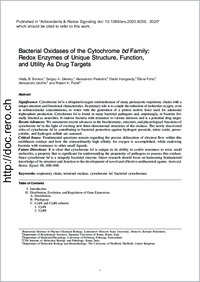Bacterial oxidases of the cytochrome bd family : redox enzymes of unique structure, function, and utility as drug targets
- Borisov, Vitaliy B. Belozersky Institute of Physico-Chemical Biology, Lomonosov Moscow State University, Moscow, Russian Federation.
- Siletsky, Sergey A. Belozersky Institute of Physico-Chemical Biology, Lomonosov Moscow State University, Moscow, Russian Federation.
- Paiardini, Alessandro Department of Biochemical Sciences, Sapienza University of Rome, Rome, Italy.
- Hoogewijs, David Department of Medicine/Physiology, University of Fribourg, Fribourg, Switzerland.
- Forte, Elena Department of Biochemical Sciences, Sapienza University of Rome, Rome, Italy.
- Giuffrè, Alessandro CNR Institute of Molecular Biology and Pathology, Rome, Italy.
- Poole, Robert K. Department of Molecular Biology and Biotechnology, The University of Sheffield, Sheffield, United Kingdom.
-
09.11.2020
Published in:
- Antioxidants & Redox Signaling. - 2021, vol. 34, no. 16, p. 1280-1318
English
Significance: Cytochrome bd is a ubiquinol:oxygen oxidoreductase of many prokaryotic respiratory chains with a unique structure and functional characteristics. Its primary role is to couple the reduction of molecular oxygen, even at submicromolar concentrations, to water with the generation of a proton motive force used for adenosine triphosphate production. Cytochrome bd is found in many bacterial pathogens and, surprisingly, in bacteria formally denoted as anaerobes. It endows bacteria with resistance to various stressors and is a potential drug target.Recent Advances: We summarize recent advances in the biochemistry, structure, and physiological functions of cytochrome bd in the light of exciting new three-dimensional structures of the oxidase. The newly discovered roles of cytochrome bd in contributing to bacterial protection against hydrogen peroxide, nitric oxide, peroxynitrite, and hydrogen sulfide are assessed.Critical Issues: Fundamental questions remain regarding the precise delineation of electron flow within this multihaem oxidase and how the extraordinarily high affinity for oxygen is accomplished, while endowing bacteria with resistance to other small ligands.Future Directions: It is clear that cytochrome bd is unique in its ability to confer resistance to toxic small molecules, a property that is significant for understanding the propensity of pathogens to possess this oxidase. Since cytochrome bd is a uniquely bacterial enzyme, future research should focus on harnessing fundamental knowledge of its structure and function to the development of novel and effective antibacterial agents.
- Faculty
- Faculté des sciences et de médecine
- Department
- Département de Médecine
- Language
-
- English
- Classification
- Biological sciences
- License
-
License undefined
- Identifiers
-
- RERO DOC 329903
- DOI 10.1089/ars.2020.8039
- Persistent URL
- https://folia.unifr.ch/unifr/documents/309145
Statistics
Document views: 132
File downloads:
- pdf: 318
